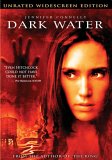Synopsis
Jennifer Connelly is going through a messy divorce with Dougray Scott. They are feuding over the custody of their daughter. Trying to piece her life together, Connelly rents an apartment in a down-at-the-heels building on Roosevelt Island in New York City. A leak develops in her ceiling that keeps getting worse. Her daughter develops an imaginary friend. The supernatural events gather force, apparently determined to drive her out of her mind.
In the extras, the filmmakers make much…about the influence of Roman Polanski, and Dark Water is very much in the tradition of Rosemary’s Baby, The Tenant and Repulsion. It does its models no dishonour, too. The oppressiveness of the environment is beautifully realized, and Connelly, here returning to her horror roots (Phenomena, AKA Creepers), does stellar work. She is utterly convincing as a woman at the end of her tether. Just because They are out to get her, that doesn’t mean she isn’t paranoid. The film is very faithful to the original Japanese version, and while the ghost itself is less creepy than in the original, the story has adapted itself extremely well to the American context, and the overall film is arguably, as with The Ring and The Grudge, superior to the source. It is now at least as much a psychological thriller as it is a ghost story. This edition boasts that it is “unrated.” Whatever the differences are with the theatrical release, they’re pretty subtle. It’s a testament to the topsy-turvy world of DVD releases. While an unrated status is death on a film in the theatres, it’s a selling point in the stores. For anyone wondering, no, there is no sex or violence in this film, so the unrated status is meaningless.
Audio
The 5.1 is a superb track, especially when it comes to anything to do with water. Rain pouring down, water swirling in apartments, whatever. If it’s wet, you’re plunged into it, suffering along with Connelly. The sound design, one of the creepier aspects of the film, is wonderfully realized. The bass is great, generating deep, almost subaural rumbling. Water and rumbling effects combine to great effect in the washing machine scene. The dialogue is clear and free of distortion, and the music sounds pretty fine, too.
Video
This is a crisp 2.35:1 anamorphic widescreen transfer. The image is perfectly sharp, and there is no grain or edge enhancement. The colours, grim and grey as they frequently are, and very well rendered (and for all that the palette is pretty depressing, there are plenty of subtleties at work too, and these are perfectly captured by the transfer). The blacks are great, as are the flesh tones. No artifacting problems either. This is a great-looking disc.
Special Features
The features are a little disappointing. There is, for instance, no commentary. “Beneath the Surface” is a 5-part featurette, which isn’t a bad example of its kind, but is still promotional in nature (as is the case with the “Extraordinary Ensemble” piece). Director Walter Salles has some very interesting things to say, and it would have been nice to hear a commentary from him (the producers, however, are irritating in their “this isn’t really a horror movie” attitude – I thought we’d left the bad old days of the 90s behind). “The Sound of Terror” covers sound design, and is also fine (again, as featurettes go). There are two deleted scenes. The most in-depth feature is the analysis one. Here the editors discuss two scenes, and then one can watch the bathroom sequence with six different sound mixes (including the final mix) or with commentary. There are seven trailers for other releases. The menu is animated and scored.
Closing Thoughts
A film that improves on second viewing, and very nice picture and sound. One could do with a bit more in the extras department.
Special Features List
- Making-of Featurettes
- Scene Analysis
- Deleted Scenes
- Trailers






01/06/2006 @ 10:58 pm
this movie was too confusing